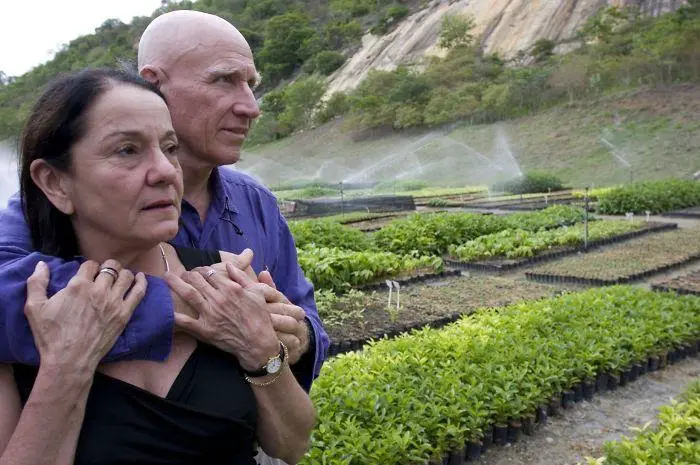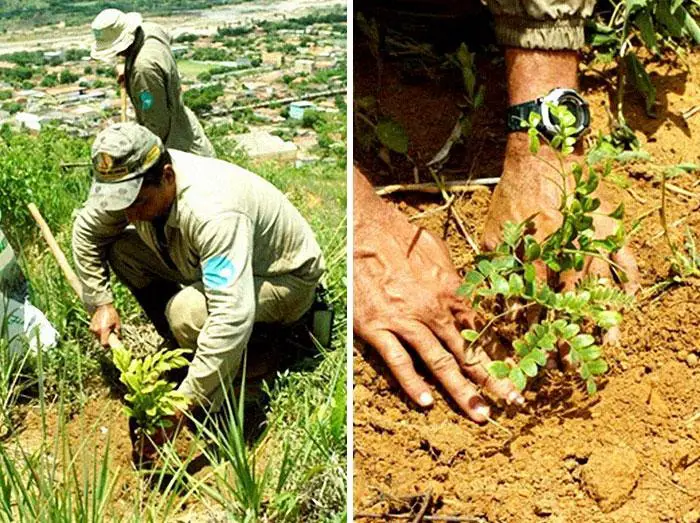If you ever need a visual description of the phrase, “We can change the world together”, this couple and their volunteers pulled it off and gave us all hope in a gloomy reality.
It’s tough to imagine what goes on in the minds of governments and private companies who relentlessly cut down logs and trees in forests for construction. Why destroy so much and not make any solid efforts to repopulate? According to reports from the United Nations Food and Agriculture Organization, over 129 million hectares of vegetation have been ravaged and destroyed since 1990 due to deforestation. [1]
Deforestation contributes to about 15% of all climate change triggers, and it’s heartbreaking to imagine the amount of wildlife and native lands being grazed through as forests are relentlessly destroyed. [2]
When people think about climate change, we often feel helpless in the harsh reality of something so seemingly uncontrollable. What can we do to significantly make a difference? Do our efforts even count? Well, this couple has proven that even the smallest tree planted can bring about a beautifully positive change. [3]
When renowned Brazilian photographer, Sebastião Salgado, and his wife, Lélia Salgado, returned to their native land in 1994, they were shocked to discover how arid and dried up their homeland had become. Salgado had returned to take over his family land in the Brazilian state of Mina Gerais. He’d spent a long time documenting the horrifyingly tragic events of the Rwandan genocide in the 1990s. He was broken, physically and emotionally distressed, and coming home to meet his land so devastated worsened his condition. However, his wife remained positive through the dark times.

“The land was as sick as I was – everything was destroyed,” Salgado said. “Only about 0.5% of the land was covered in trees. Then my wife had a fabulous idea to replant this forest. And when we began to do that, then all the insects and birds and fish returned and, thanks to this increase of the trees I, too, was reborn – this was the most important moment.”
A groundbreaking achievement

Knowing they couldn’t follow up with their plans all alone, the Salgados set up the Instituto Terra non-profit organization and recruited workers and volunteers to help with the plan. From funds raised through donations and personal savings, the couple led their team to repopulate 1,502 acres of forest in the Bulcão Farm in Aimorés, Minas Gerais. The project began in 1998 but the first trees weren’t planted until December 1999. The farmland was renamed Private Natural Heritage Reserve (PNHR) and became the object of extensive agricultural experimentation as over 290 tree species have been planted.
Twenty years later, in 2019, the PNHR recorded more than 2.7 million trees spanning the entire expanse of their reverse. This project is now regarded as one of the most remarkable restoration attempts in world history, and an inspiration to millions of people out there to fight back against climate change.
Salgado later said that if he learned anything from the project, it was that planting trees was the most reliable solution in the struggles.

“Perhaps we have a solution. There is a single being which can transform CO2 to oxygen, which is the tree. We need to replant the forest. You need forest with native trees, and you need to gather the seeds in the same region you plant them or the serpents and the termites won’t come. And if you plant forests that don’t belong, the animals don’t come there and the forest is silent. We need to listen to the words of the people on the land. Nature is the earth and it is other beings and if we don’t have some kind of spiritual return to our planet, I fear that we will be compromised.”

Along with the bubbling trees, several other parts of the ecosystem that previously disappeared have returned to the PNHR, including:
- 15 species of amphibians.
- 293 species of plants.
- 33 species of mammals have returned, two of which are categorized as vulnerable.
- 15 species of reptiles.
- 172 bird species, six of which were facing extinction
Additionally, the trees now provide a means to stop soil erosion and eight natural springs within the forest are flowing again, even in drought periods. The trees gave life to the forest once again, attracting animals that weathered and shaped the terrain to bring the entire ecosystem back to life.
Just amazing!
Consolidating their efforts
In February 2002, Salgado and his wife created the Center for Environmental Education and Restoration (CERA) as an educational backup for the Instituto Terra. They realized the importance of targeted education and research in their work. The progress wouldn’t be sustained if people were not enlightened about the core processes involved in restoration. Also, they needed an organization to share new technologies and unite their efforts to save the Brazilian and global vegetation masses.
Starting in the states of Espírito Santo and Minas Gerais, CERA has recorded over 700 educational projects and 65,000 members as of 2012. Over 17,000 acres of land have been restored across the Valley of the River Doce and the efforts of CERA continue to stretch across Brazil.
Salgado said to the Guardian in 2015: “People’s eyes have been opened. The initial interest was commercial, but now people can see the impact of planting trees. As the trees come back, the rains improve and when the storms come, they no longer sweep away the villages. The animals and wildlife are returning. People feel better. It’s all spiraling.” [4]

References
- “Deforestation slows, ‘but we need to do better’ on sustainable forest use – UN agriculture.” UN News. Retrieved September 23, 2020.
- “Deforestation and Forest Degradation.” World Wild Life. Retrieved September 23, 2020.
- Couple Plants 2.7 Million Trees To Restore Brazilian Forest Home To Endangered Species.” Intelligent Living. Andrea D. Steffen. Retrieved September 23, 2020.
- “Sebastião Salgado focuses on big picture with parable of reforestation in Brazil.” The Guardian. John Vidal. Retrieved September 23, 2020.


